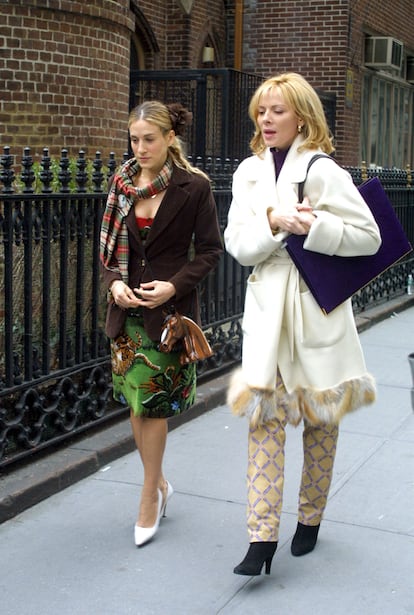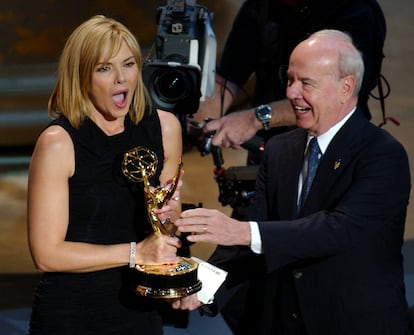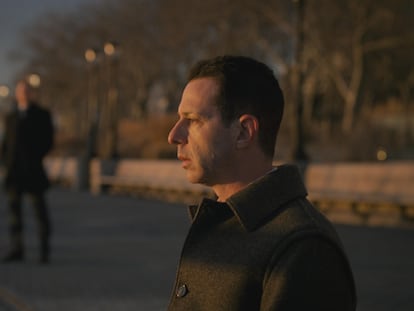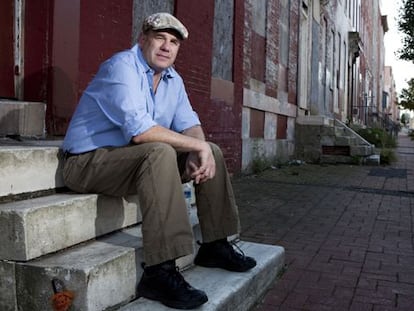The rise, fall and return of ‘Sex and the City’s’ most beloved character: ‘I didn’t kill Samantha! I released Samantha’
To the surprise and delight of fans, actress Kim Cattrall, who vowed never to return to the hit HBO show, will appear in the second season of its sequel, ‘And Just Like That…,’ which airs next week


The actress Kim Cattrall has said hundreds of times — in TV interviews, news stories, and public appearances — that she would never again step back into the shoes of Samantha Jones, everybody’s favorite free-spirited PR professional from Sex and the City. Nevertheless, and perhaps (as many fans assume) in exchange for a sizeable paycheck, Cattrall has just announced that the beloved character will return for a cameo appearance in the show’s sequel, And Just Like That…, which premiers its second season this month on HBO Max. The news — and on this point, there is little to zero disagreement — was met with surprise and delight by the series’ adoring viewers, who were devastated to see Cattrall’s character go.
The news dropped like a bombshell for fans, who knew that the actress’s relationship with her co-stars (especially Sarah Jessica Parker) had reached an apparent breaking point in 2018, when the she publicly rebuked Parker on Instagram, calling her “hypocritical” and “cruel” and linking to a New York Post piece exposing the “mean-girls culture” that plagued the filming of the original series, which aired from 1998 to 2004 on HBO, and claiming that the show’s other actors, led by Parker, had conspired to isolate and ignore her. The fact that Cattrall shared the piece on social media made it clear that she shared its version of events. Sarah Jessica Parker has always denied the claims were true.
Five years later — one week ago — Cattrall broke the unthinkable news on Instagram, sharing a link to Variety’s exclusive, which announced the return of Samantha Jones. The post was accompanied by a short and sweet comment — “Happy Pride...” — that prompted several different readings: was it a homage to the show’s LGBTQ fans, who adored Samantha? Obviously, but Cattrall’s “pride” had another subtext, suggesting, perhaps, that she was as free as her character in Sex and the City and had every right to change her mind — to do what she wanted, just as Samantha would have done (and incidentally, to get a lot of money for it).


Before this — before the comeback and the controversies and the drama — the freest and most scandalous thing Samantha had done in the show was to disappear. And thus, Kim Cattrall became an unexpected symbol of assertiveness and individuality, by repeating the word “no” and refusing to return. One might even say that she embodied a noble and necessary resistance, facing down the dominant cultural and audiovisual paradigm that forces everything and everyone to return. Fans of Sex and the City were clamoring for a third film, but she said “no,” knowing that you don’t always have to give the audience what they want. In the streaming era, all characters are resurrected. Our favorite series from the eighties, nineties, and early aughts are back. ABBA is back. And even The Beatles are singing again thanks to artificial intelligence. But Cattrall, despite request after request and offer after offer, had always responded with a firm and resounding “no,” for 13 years.
To revive Samantha, she maintained, would just be to kill her slowly. There was even a script for a third movie, but filming was cancelled when Cattrall refused to participate. In the script, according to rumors, the character of Mr. Big — the partner of the show’s protagonist, Carrie, played by Chris Noth — would die (as happens, instead, at the beginning of And Just Like That…), and the most remarkable development in the life of Samantha, once again relegated to the role of a sidekick, was that she would receive explicit photos from Miranda’s son (Cynthia Nixon), who in the film’s script was only 14 years old. This internet gossip was confirmed by Cattrall herself, in an interview in Variety in 2021. “Isn’t it heartbreaking?” she said, commenting on the plot. In an excerpt from an interview with Piers Morgan (the video’s five million YouTube views attest to how much interest there is in this topic), Cattrall sums up her attitude, her unwavering “no.” Morgan prods her: “They’re all basically blaming you, for ruining everybody’s fun: ‘There can’t be anymore Sex in the City, because you’ve killed Samantha!’” Cattrall quips back with determination: “I haven’t killed Samantha! I have released Samantha.”


Anyone who saw the two films that followed the series (the first released in 2008 to lukewarm reviews, the second in 2010 and featured in several worst-of-the-year lists, and both elegantly ignored in the plot of And Just Like That…) can confirm that the treatment of Samantha was, indeed, disappointing. For millions of fans, she was the show’s best character and a true heroine (an opinion backed by Movieline, The Guardian, New York Magazine, Out and Screenrant). But in the two feature-length films, Samantha is limited to chasing men in the background, or complaining because there are no men to chase. She had gone from hero of female sexual liberation to female Benny Hill. Not that anyone expected her to never talk about or have sex — she put the sex in Sex and the City, after all — but fans missed the more nuanced and complex role she played in the show.
Cattrall herself was quite critical of the films’ scripts. In a 2013 interview with EL PAÍS, she confessed: “The times we live in call for a much more realistic point of view, about sex and about everything else — a perspective that not only entertains, but also educates. Maybe that was the mistake we made with the movies. The characters should have evolved, but they stayed the same. The message got old. The bad reception it got was a sign the times had changed.”

In her interview with Variety, Cattrall not only laments her character’s trajectory, but offers ideas about how Samantha could have been ascribed more dignity and newfound relevance: “Why couldn’t Samantha, who had her own PR agency, sell the business because of the economic crisis. 2008 was so hard. She could have sold the company to a guy in a hoodie, and that could have been the plot dilemma. That would have been a good conflict.” Instead, Samantha was portrayed as desperate, lamenting the fact that she didn’t have enough sex with her boyfriend, and her most memorable scene is when she waits for him on Valentine’s Day, naked and covered in sushi.
Sex and comedy were both central to the character of Samantha, of course. To deny that would be to deny the essence of her character. During the show’s six seasons, Samantha slept with men she had forgotten she had slept with before, had sex with guys with undersized penises and oversized penises, had threesomes, developed an infatuation with a priest, dated a woman, dated a dwarf, dated a guy whose semen tasted terrible, slept with a porn star, returned a vibrator because it didn’t give her good orgasms, and hung up the phone on Charlotte after telling her: “I’m masturbating, I told you I’d be doing that all day today.” Samantha was the most free, modern and memorable character of the series, and gave rise to the eternal joke of whether her character was, at heart, the fantasy of a homosexual man. (Darren Star and Michael Patrick King, the respective creator and soul of the series, were both gay, and in the The Simpsons, Marge famously quipped about Sex and the City: “That’s the show about four women acting like gay guys”).
But apart from all that, Samantha was also the only one who never judged the rest — the only one who was clear that she wanted neither romantic commitments nor children, and who never shied away from exploring themes like menopause, the triggers of sexual desire, aging beauty, or the blurred line that separates love for the self and love for others. In one episode, she tells her boyfriend before leaving him, and on the verge of losing her mind, “I love you, too, Richard, but I love me more.”
“Today, Sex and the City is seen as a very conservative series, where the message is that the most important thing in life is to find a partner, and that no life can be complete without one,” notes Raquel Piñeiro, a journalist and the writer and creator, along with Patricia Blanco, of Sexo en Nueva York Podcast, a Spanish-language podcast that analyzes the series episode by episode and features discussions on how the plot would be received in today’s very different world. “Samantha was the one character who subverted the idea of romantic love,” Piñeiro says. “She was the only one who was truly satisfied with a life of promiscuity, and did not apologize for enjoying sex, for earning a lot of money, for spending it how she wanted and ignoring other people’s criticism.” For Piñeiro, the decision of the actress (who turned down the role three times before finally accepting it) was key. “Cattrall made sure that her character did not become a caricature, that Samantha was someone audiences could empathize with, beyond the figure of the sympathetic slut that funny things happen to,” Piñeiro says. “She represented the vindication of the slut, showing us that it could be a positive role. Being a woman with power was groundbreaking 25 years ago, and it still is today.”

Samantha was also one of the first women to be shown on a TV show getting tested for HIV (in episode 11 of the third season). Spanish screenwriter and director Juan Flahn, whose work features female characters in series such as Mujeres (TVE, 2006), notes that the scene may have played an important role in the character’s emergence as a gay icon — a role Cattrall has apparently acknowledged herself, with her recent Instagram post. Flahn continues: “She was the most promiscuous, the one who had the most sex, who did it with the most freedom and with the least amount of anxiety and apprehension. But there is also, more recently, the added element of her rivalry with her castmates in real life, something that appeals to a certain homosexual sector of a certain social moment, that enjoys fights between great women and can project them into the fictional series itself. That development was the icing on the cake of Samantha’s character. If it were another character or another series, no one would be paying as much attention.”
One wonders, of course, what Cattrall’s return will actually look like on screen. Samantha is not just any character, and the story behind her and the actress who plays her, is not just any story, but a notorious and public confrontation. We know that her appearance will be brief (and that she will not be filming in the company of any of her former castmates), and that her character will not be permanently returning to the show. And we know that it’s about business, not a gesture of reconciliation. In the first season of And Just Like That…, Samantha’s absence was attributed to a fight she had had with Carrie, which prompted her to move to London, and her character became a kind of ghost who from time to time would appear in the form of a voicemail message. At the end of the first season, the two characters were planning to meet. The show is openly aware of the huge absence left by Cattrall: in the first scene of the first episode, her name is mentioned by way of explaining her absence, and then mentioned again throughout the season. The character of Seema, played by the British actress Sarita Choudhury, recalls Samantha in her outspoken character and love of sex. But And Just Like That… doesn’t hold up without the original Samantha, and the show knows it. And now we know that Kim Cattrall, despite claiming never to have seen the series, knows it too.
Sign up for our weekly newsletter to get more English-language news coverage from EL PAÍS USA Edition
Tu suscripción se está usando en otro dispositivo
¿Quieres añadir otro usuario a tu suscripción?
Si continúas leyendo en este dispositivo, no se podrá leer en el otro.
FlechaTu suscripción se está usando en otro dispositivo y solo puedes acceder a EL PAÍS desde un dispositivo a la vez.
Si quieres compartir tu cuenta, cambia tu suscripción a la modalidad Premium, así podrás añadir otro usuario. Cada uno accederá con su propia cuenta de email, lo que os permitirá personalizar vuestra experiencia en EL PAÍS.
¿Tienes una suscripción de empresa? Accede aquí para contratar más cuentas.
En el caso de no saber quién está usando tu cuenta, te recomendamos cambiar tu contraseña aquí.
Si decides continuar compartiendo tu cuenta, este mensaje se mostrará en tu dispositivo y en el de la otra persona que está usando tu cuenta de forma indefinida, afectando a tu experiencia de lectura. Puedes consultar aquí los términos y condiciones de la suscripción digital.
More information
Archived In
Últimas noticias
Most viewed
- Sinaloa Cartel war is taking its toll on Los Chapitos
- Oona Chaplin: ‘I told James Cameron that I was living in a treehouse and starting a permaculture project with a friend’
- Reinhard Genzel, Nobel laureate in physics: ‘One-minute videos will never give you the truth’
- Why the price of coffee has skyrocketed: from Brazilian plantations to specialty coffee houses
- Silver prices are going crazy: This is what’s fueling the rally










































